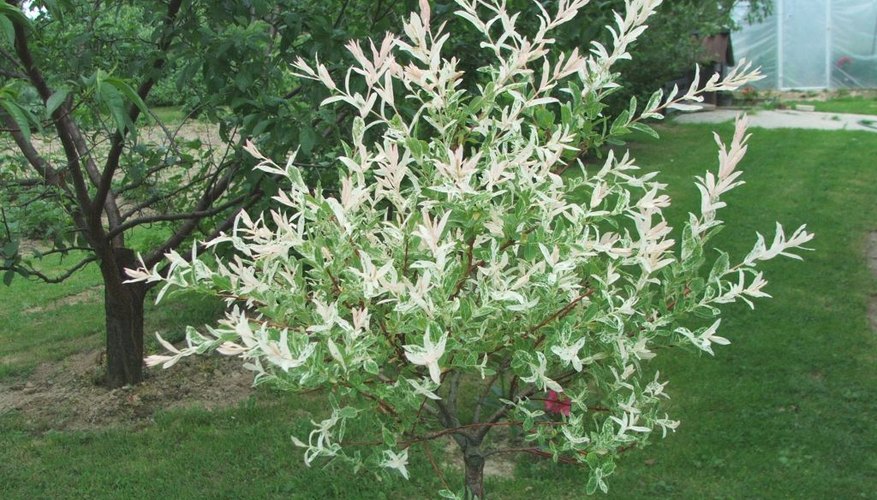The dappled willow (Salix integra) is a small deciduous tree with foliage so brilliant it rivals the blooms of flowers for providing colour and interest. Pink buds appearing in the spring mature into striking variegated white and green leaves in the summer, while in autumn, the dappled willow's leaves turn yellow. Dappled willows do well in containers; the dwarf Hakuro-nishiki variety -- which usually only reaches 1.8 m (6 feet) tall -- is particularly well suited to growing in pots. With the proper planting and care, you can have a dappled willow brightening your patio or terrace.
Requirements
The dappled willow grows best in wet, porous, rich soil, with a pH of 5.6 to 7.8 -- the slightly acidic to alkaline range. Either sandy soil or clay soil is acceptable, but the dappled willow can't tolerate drought or compacted soil, which prevents proper water absorption. It will grow in partial shade, but for its colours to be their most spectacular, it needs full sun.
Planting in a container
The best time to plant your new dappled willow in its container is early spring or autumn when the weather is relatively cool. Avoid hot, dry, or windy days. Ensure proper drainage in the container by making sure it has sufficient holes at the bottom, and line the bottom with a large plastic or fibreglass screen to prevent soil from washing out. Plant your tree so the top of the root ball is even with the lip of the container, or even slightly above. Put enough potting soil mixture in the bottom of your container to ensure contact with the bottom of the root ball. When you place the tree in the container, have someone help you position it so it is straight and centred. To avoid leaving gaps and air holes, add water as you backfill the hole, tamping the soil every 7.5 cm (3 inches). To ensure colourful foliage, position the container in full sun.
- The best time to plant your new dappled willow in its container is early spring or autumn when the weather is relatively cool.
- Ensure proper drainage in the container by making sure it has sufficient holes at the bottom, and line the bottom with a large plastic or fibreglass screen to prevent soil from washing out.
Aftercare
Promote healthy root establishment by watering consistently to keep the soil moist. Fertilise your dappled willow with a general-purpose fertiliser every spring before new growth begins. Never fertilise after mid-August; new growth encouraged by the fertilisation will be damaged by freeze. Prune your dappled willow in the winter or in very early spring before new growth appears. Generally, dappled willows tolerate pruning very well, and you can prune for shape as well as to maintain size. Prune lightly every four to six weeks to promote new and colourful growth. To reduce the threat of diseases and pests, remove up to one third of the branches down to the ground for the first year or two. Be alert for diseases such as anthracnose, blight, crown gall and powdery mildew, as well as aphids, scale insects and borers, and treat at the first sign of infection or infestation.
- Promote healthy root establishment by watering consistently to keep the soil moist.
- Generally, dappled willows tolerate pruning very well, and you can prune for shape as well as to maintain size.
